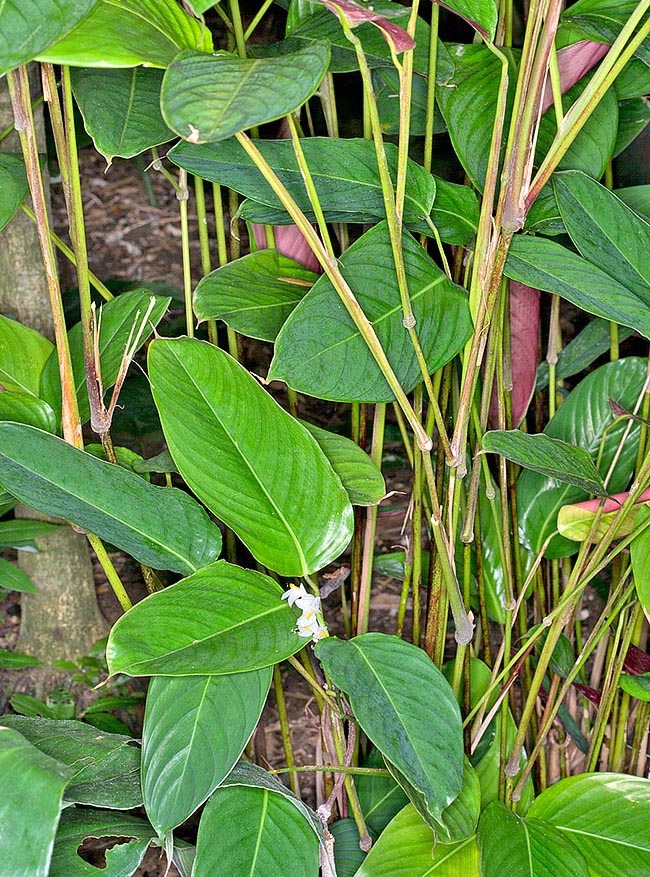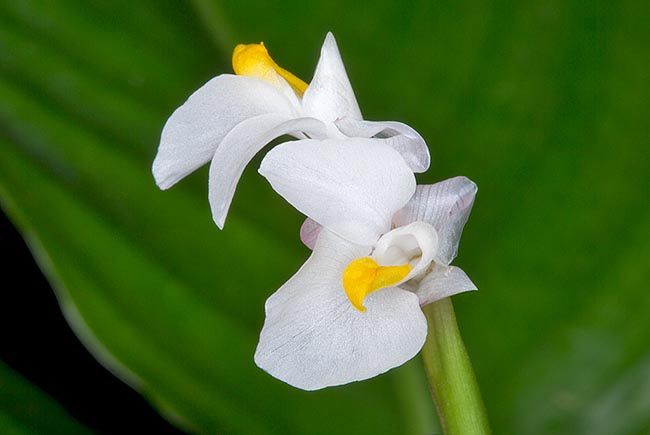Family : Marantaceae

Text © Pietro Puccio

English translation by Mario Beltramini

Marantochloa cordifolia is a perennial erect, evergreen, rhizomatous, herbaceous species of the tropical African swampy forests. Almost unknown out of its origin zones, may even be 2 m tall © Giuseppe Mazza
The species is native to Angola, Cabinda, Cameroon, Central African Republic, Congo, Democratic Republic of the Congo, Gabon and Nigeria, where it grows in the underwood of the swampy forests and along the banks of the water streams.
The generic name is the combination of Maranta, genus honoured to the Italian physician and botanist Bartolomeo Maranta (1500-1571), and of the Greek substantive “χλόη” (chloe) = grass; the specific name is the combination of the Latin substantives “cor, cordis” = heart and “folium, ii” = leaf, with obvious reference.
Common names: joanjoan (Cameroon).
The Marantochloa cordifolia (K. Schum.) Koechlin (1964) is a perennial rhizomatous herbaceous species, erect, evergreen, with thin ramified stems, forming dense tufts up to 2 m tall.
The leaves, on a 15-25 cm long petiole, are alternate, simple, ovate to oblong-ovate with long pointed apex and entire margin, 16-30 cm long and 8-18 cm broad, of glossy intense green colour above, opaque below.
Terminal ramified inflorescences, 10-25 cm long, carrying hermaphroditic flowers in pair, subtended by green bracts, with 3 unequal lanceolate sepals of white colour, 3 retroflexed white-pinkish oblong petals, stamen and staminodes arranged in two verticils, the inner one formed by the fertile stamen and by one white staminode, the outer one by two white unequal petaloid staminodes.
The fruit is a tri-lobed globose capsule, of about 8 mm of diameter, of red colour containing three trigonal seeds provided of aril.

Ramified 10-25 cm long terminal inflorescences, with small hermaphrodite flowers in pair © Giuseppe Mazza
It reproduces by seed, in draining loam maintained constantly humid at the temperature of 24-26 °C, and easily by division.
Semi-aquatic species practically unknown out of the origin zones, cultivable in the tropical and humid subtropical zones on swampy or periodically flooded soils, requires an exposition in full sun or a partial shade.
The fibres gotten from the stems are utilized by the local populations for fabricating ropes, baskets, fishing nets and other objects of common usage.
The species is part of the gorillas diet during the dry season, when the fruits of the forest run low.
Synonyms: Clinogyne cordifolia K.Schum. (1902).
